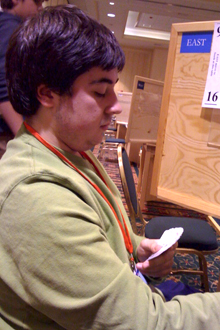Adam Grossack, world champion bridge player
First year aims to spark enthusiasm on campus for the game that is his passion

Above: Grossack competing behind a screen. On BrandeisNOW front: World champion Grossack flanked by rival medalists from Norway and Sweden. Front photo credit: Ron Tacchi / ACBL & WBF
When first year student Adam Grossack was a young boy, his mother – an avid bridge player -- signed him up for free bridge lessons. “I thought it would be nice to have a partner,” says Jori Grossack. So they went to a local bridge club not far from their hometown of Newton, Massachusetts. She remembers that when they arrived, “there was a sign at the door that said something like, ‘Come one, come all, ages nine to 90’, encouraging everyone to learn the game.”
But Adam was eight and didn’t want to go in. “He thought he was sneaking and didn’t want to do it,” his mother remembers. “I had to explain to him that ‘nine to 90’ is just an expression, that everyone is welcome.”
At first, learning bridge was slow going and Adam had trouble winning, but instead of quitting, he pored over his mother’s bridge strategy notes from her own bridge lessons.
That was ten years ago. Today Adam, age 18, is the World Champion of individual bridge players 21 and under after winning an international tournament in October in Philadelphia under the auspices of the World Bridge Federation. He beat out his closest contenders from Norway and Sweden, and was the only American to medal in all of the "under age 27" and "under age 22" events. A New York Times bridge column featured Adam's championship win.
Bridge is usually thought of as a cerebral game for adults, so when pre-teen Adam started competing in tournaments -- armed with his mother’s notes and with a mouth full of braces – he says he was ready to pounce when his adult opponents mistakenly underestimated him and let their guard down. “Most of them were trying to be friendly, saying ‘Oh, isn’t it nice to have a younger person in the game?’ and I’d play along most of the time, and would beat them,” says Adam. “That drew silence.”
He had his first big tournament win in 2003. “I was 11 years old when I won my first sectional,” Adam remembers. “I was the youngest one there.” Before long, he was playing and winning regularly, against some of the region’s best players. His mother remembers, “People didn’t realize how good he was. He’d go to a tournament and they’d think he was so cute and sweet and nice and they were shocked. He would destroy them.”
Soon enough, Adam was in demand as a bridge partner. “I was so naïve,” his mother remembers. “I didn’t realize how good he was either. Major people in the bridge world were asking to play with him and I’d tell his bridge teacher, ‘isn’t it nice that they want to play with Adam'. I later came to realize that while playing at such a high level might have benefited Adam, it probably benefited his partners just as much."
Three years after that first tournament win, Adam became New England’s youngest Life Master at the age of 14, an achievement that few adults attain even after many years of serious bridge. As a high school senior he was crowned a “King of Bridge” which came with a college scholarship.Playing at such a competitive level, Adam would be expected to have nothing but bridge on his mind, but he also played varsity football for Newton South High School. “Football and bridge are his two loves,” says Jori Grossack. “Football camaraderie was great.” During football season, Adam did not compete in bridge. “They got home at six o’clock so it was really hard when he had limited time,” his mother says. “He’d have to buckle down with homework.”
In addition to football, Adam coached basketball and umpired baseball games. He was on his high school’s mock trial team, and helped set up bridge clubs at both his middle and high schools. He is now organizing a bridge club on the Brandeis campus and says several students seem interested. Adam's connection to Brandeis runs deep; his grandmother, Judith Grossack, was in the second graduating class.
The game of bridge requires a true partnership. Four people sit around a square bridge table. Partner pairs sit across from one another, constituting the two opposing ‘teams’. Once all the cards are dealt but before they are played, each pair bids on how many ‘tricks’, or rounds of play, they believe they can win.
The bidding process is elegant and nuanced. “It was almost like bidding itself is like a language where you are communicating with your partner about what cards you are holding,” says Adam, who is fascinated with the variety of bidding methods used world-wide. “Each country has its own systems,” he says.
When playing the highest level of competitive bridge, as Adam does, a screen is erected so that the partners cannot see one another. “You can’t see facial expressions, so by having your partner and your opponent behind a screen, it takes away that advantage,” says Adam, who still listens for clues. “In the bidding, you learn something from how long it takes them to bid.”
Adam is now preparing for his next tournament later this month, the North American pairs. That means getting ahead on his schoolwork. He says that so far his Brandeis professors have been very supportive of his tournament play.
Asked about pre-tournament rituals, Adam takes a sensible approach. “I get a good night’s sleep and I have a good breakfast. Before the last session of the event, I sort of visualize myself winning, but beyond that I don’t have any rituals,” he says, “I sort of just sit down and play.”
Categories: General, Student Life





